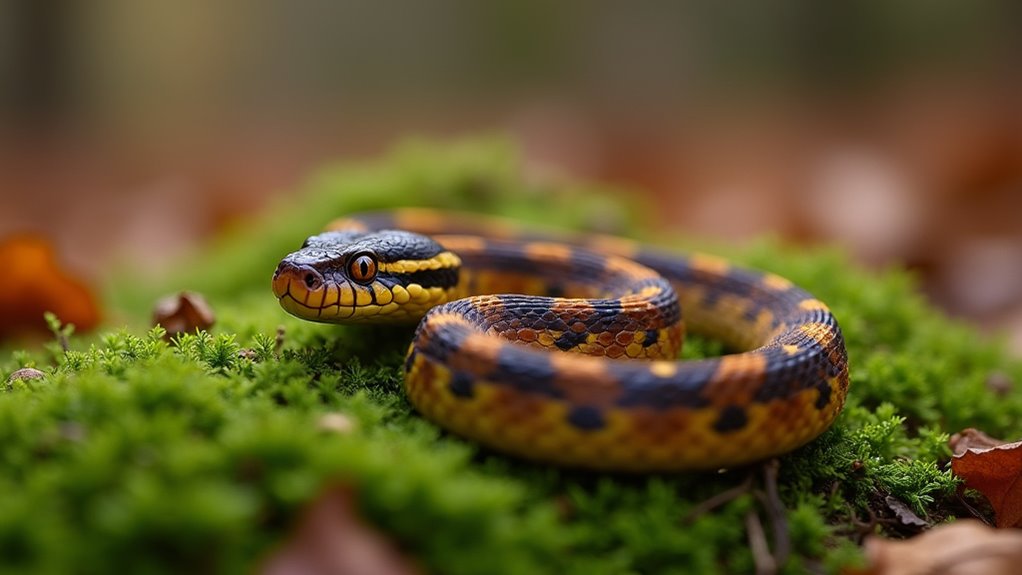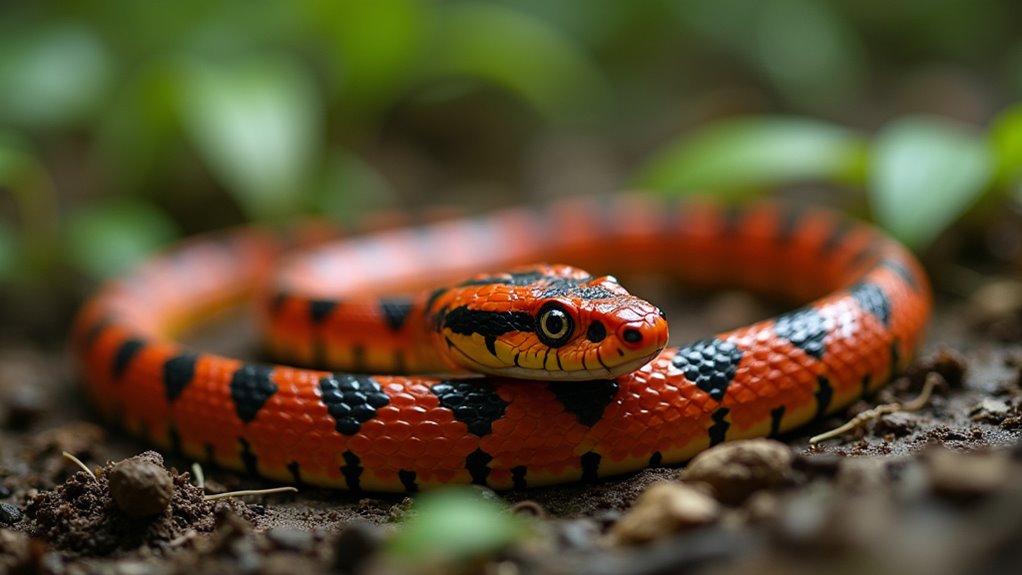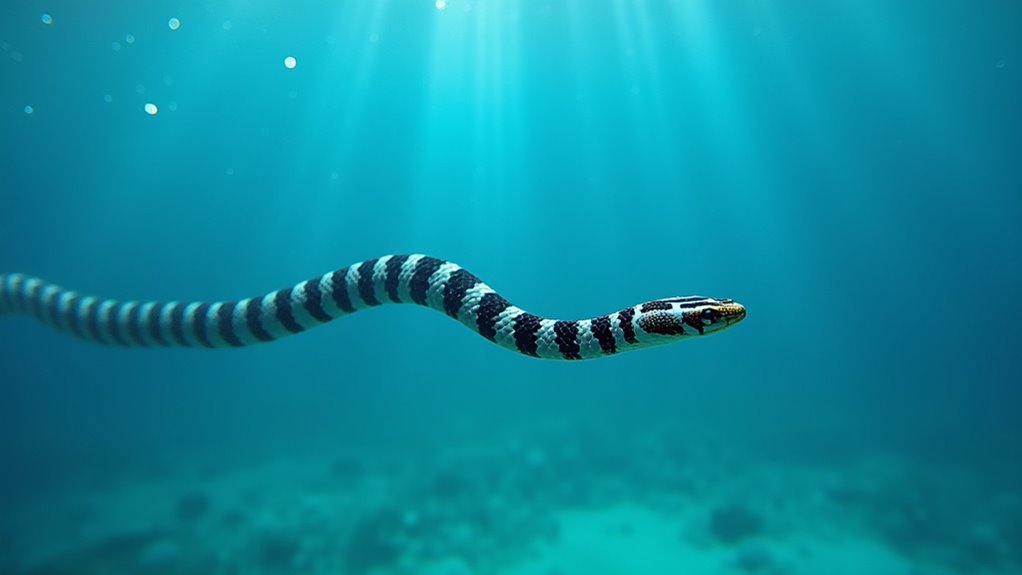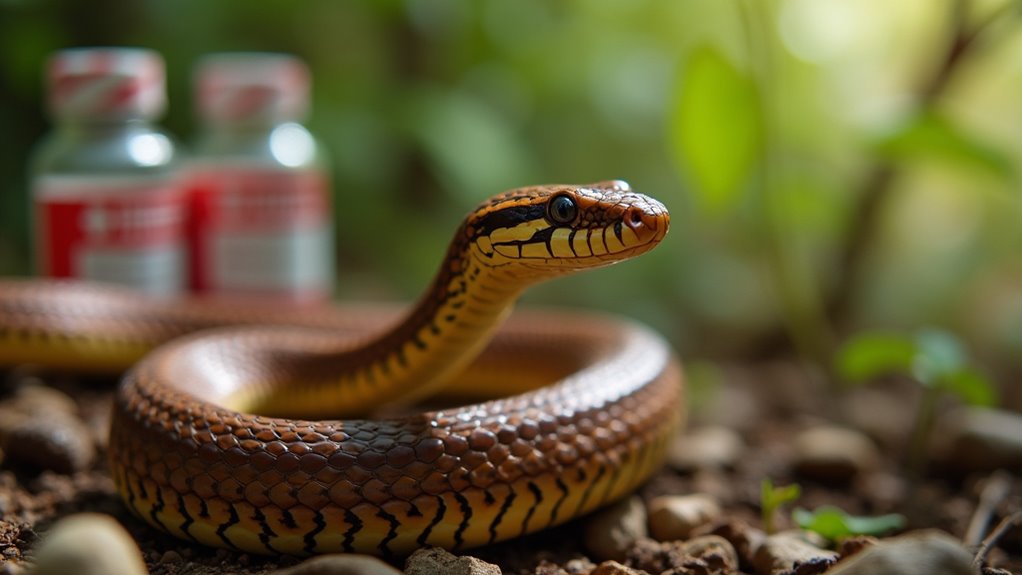Physical Address
304 North Cardinal St.
Dorchester Center, MA 02124
Physical Address
304 North Cardinal St.
Dorchester Center, MA 02124

The most dangerous snakes lurking in Japan's wilderness can kill within hours, but knowing these 7 species might save your life.
Japan’s most dangerous snakes include the deadly Mamushi (Japanese Pit Viper), which causes 2,000-3,000 bites annually, and the large Habu found in Okinawa. You’ll also need to watch for the Yamakagashi (Tiger Keelback), Himehabu (Princess Viper), and venomous sea snakes in southern waters. Each species has distinct habitats, appearances, and venom effects. Knowing how to identify these serpents and respond to bites could save your life in an emergency.

The Mamushi snake stands as Japan’s most dangerous venomous serpent, scientifically known as Gloydius blomhoffii. You’ll find these 45-81 cm vipers in woodlands, meadows, and even near farms across Japan, with their gray to reddish-brown bodies featuring distinctive lateral blotches.
These ambush predators hunt both day and night, targeting small mammals, frogs, and birds. The snake uses its excellent camouflage in vegetation to surprise prey, making it an efficient hunter in its habitat.
Patient hunters in the shadows, Mamushi vipers strike from concealment to catch unwary prey at any hour.
When threatened, they’ll strike with venom containing potent neurotoxins and anticoagulants.
Each year, the Mamushi bites 2,000-3,000 people in Japan, causing symptoms like blurred vision, kidney failure, and in severe cases, death—with up to ten fatalities annually.
If bitten, you’ll need immediate hospitalization, possibly for a week or longer in intensive care.
While the Mamushi claims the title of Japan’s deadliest snake on the main islands, Okinawa faces its own venomous threat. The Habu snake, growing up to 8 feet long with distinctive yellow-green coloration and dark blotches, inhabits rock walls, caves, and tombs across the island. The snake is scientifically classified as Trimeresurus flavoviridis and is endemic to the region.
These powerful pit vipers are equipped with:
If you’re exploring Okinawa, be cautious around rocky areas and wooded regions. Though fatalities are rare, Habu bites require immediate medical attention.
The snake’s population has declined due to overhunting for snake wine and predation by introduced mongooses.

Despite its gentle appearance and non-aggressive nature, the Yamakagashi (Tiger Keelback) ranks among Japan’s most dangerous snakes due to its powerful anticoagulant venom.
You’ll find this olive-green snake with orange flanks and black spots throughout Japan, particularly near water. Though it primarily eats frogs and fish, it’s the Yamakagashi’s unique defensive system that makes it lethal.
When threatened, it can deliver venom through rear fangs and discharge poison from specialized neck glands. The Tiger Keelback displays passive defensive responses when temperatures are cool, including flattening its body and remaining motionless.
If bitten, you’ll experience internal bleeding and coagulation failure. Since 1917, Japan has recorded 29 cases, including one fatality.
Fortunately, antivenom exists if you seek immediate medical attention.
The Yamakagashi hibernates in winter, so your risk of encounter is highest from April to October.
Nestled in the subtropical islands of Okinawa and the Amami group, the Himehabu (Princess Viper) represents one of Japan’s most intriguing venomous snakes. This stout-bodied, pale greenish-brown serpent with distinctive darker blotches is remarkably active even at lower temperatures, unlike many other snake species.
When you’re exploring the Ryukyu Archipelago, remember these essential facts:
While not typically fatal, a bite from this “Princess Viper” demands immediate medical care and proper respect for their territory. The Okinawan people have a specific name for this snake, referring to it as Niibuyaa in their local language.

Beneath the azure waters surrounding Japan’s southern islands swim some of the ocean’s most potent predators: venomous sea snakes. The black-banded sea krait, locally known as “erabu,” is common throughout Okinawa and the Ryukyu Islands.
Researchers recently confirmed Hydrophis stokesii’s presence in Japanese waters.
Hydrophis stokesii joins the roster of venomous marine serpents lurking in Japan’s coastal ecosystem.
Don’t let their graceful swimming fool you. These relatives of cobras pack neurotoxic venom that can be life-threatening without treatment. Though they rarely attack humans unprovoked, you should exercise caution. Their venom is ten times stronger than cobra venom, making encounters potentially deadly.
If you’re exploring coastal waters, learn to identify the black-banded sea krait by its distinctive dark bands on a bluish-gray body. Avoid handling any sea snake, wear protective footwear on rocky shores, and seek immediate medical attention if bitten.
When hiking through Japan’s diverse landscapes, your ability to identify venomous snakes could save your life. Japan’s most dangerous serpents have distinctive characteristics you’ll want to memorize before venturing outdoors.
Always watch for snakes near rocks, drains, and shaded areas.

Despite your knowledge of snake identification, encounters with venomous species can still occur. If bitten, remain calm and slowly move away from the snake to prevent additional strikes. Remove any constricting items like jewelry and keep the affected limb below heart level.
Don’t attempt to cut the wound or suck out venom—these methods are ineffective and dangerous. Instead, seek immediate medical attention at a facility equipped to handle snakebites. During transportation, keep the victim as still as possible.
Treatment typically involves antivenom, particularly species-specific ones for Mamushi or Habu bites. Newer approaches include radical fang mark ablation and chelating agents like EDTA. The most effective outcomes occur when antivenoms are administered within 3 hours post-bite, though treatment should not be delayed even if this window has passed.
Medical professionals will provide supportive care and monitor for complications such as anaphylaxis, inflammation, or systemic effects.
Japan’s venomous snakes won’t all actively hunt you down, but they’re nothing to mess with. You’ll need to exercise extreme caution when exploring Japanese wilderness areas. Keep this guide handy, memorize these deadly species, and you’ll dramatically improve your chances of survival. Remember, quick action after a bite makes the difference between life and death. Stay alert, respect these powerful creatures, and you’ll return home with amazing stories instead of fang marks.